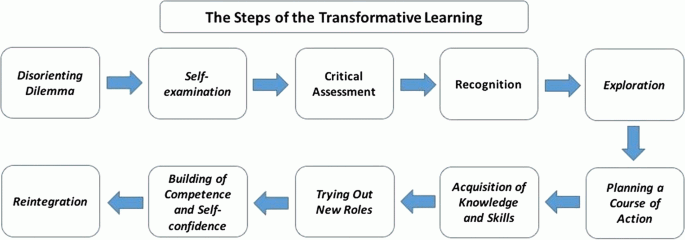The phases of transformative learning
In the transformative learning theory there are typical phases that adult education learners follow. These phases are key in helping adult education learners transform their prior notions as they get new information and insight.
- A disorienting dilemma. A disorienting dilemma is a situation where a learner finds that what they thought or believed in the past may not be accurate. This is the first part of transformational learning. This can be an “a-ha” moment where a student hears or consider something they may not have understood before. This disorienting dilemma can be uncomfortable or challenging for students, but is the key spark in starting a fire of transformational learning.
- Self-examination. After a disorienting dilemma, students will do a self-examination of their beliefs and understanding. They will think about their past experiences and how they connect to this disorienting dilemma. This can create a perspective transformation, where students understand that their perspective may not be the only perspective.
- Critical assessment of assumptions. Students in this phase of transformational learning are able to take a more comprehensive look at their past assumptions and review them critically. They are able to accept that perhaps some of their past assumptions were wrong, and are thereby more open to new information and thoughts. This creates perspective transformation as they are able to look with more unbiased eyes at their own past.
- Planning a course of action. After students understand how their past assumptions and beliefs may have been wrong and have a perspective transformation, they are able to plan a course of action. They are able to consider what kinds of learning they will now need to more fully understand a problem or situation. They will be able to have a strategy for learning new things, seeing new perspectives, talking to new people, and more.
- Acquisition of knowledge or skills to carry out new plan. Now is the time for students to carry out their plan and get further in their transformational learning. They may have to learn new things and consider different perspectives in order to fully enhance their learning. This may take extensive work and effort, but this is where the real learning is happening.
- Exploring and trying new roles. As part of transformational learning, we need to act. In transformative learning, exploring and trying to understand changes is key to success. It goes beyond just learning about something, but actively working to understand and experience new things for yourself.
- Building self-efficacy in new roles and relationships. Self-efficacy involves us being able to make our own decisions and have our own beliefs. As we follow transformative learning phases it’s extremely important to build confidence in our beliefs and understanding, and to continue to practice this transformative cycle as we move forward.

Source: Mezirow Model of Transformative Learning (essaywritingserviceuk.co.uk)
最終更新日時: 2022年 06月 20日(Monday) 15:35